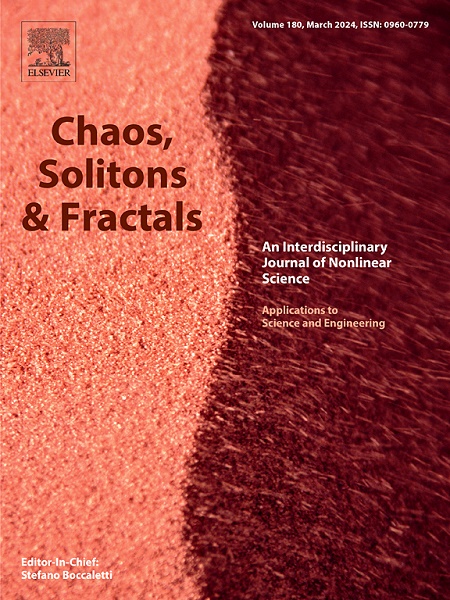Reversible image encryption and hiding algorithm based on fractional-order memristive Hopfield neural network
IF 5.3
1区 数学
Q1 MATHEMATICS, INTERDISCIPLINARY APPLICATIONS
引用次数: 0
Abstract
In order to protect the privacy information of images in the Industrial Internet of Things(IIoT), this paper mainly studies an image encryption and hiding method based on Fractional-Order Memristive Hopfield Neural Network (FOMHNN). Firstly, a FOMHNN model is proposed with variable neuron activation gradient and synaptic weight. Then, boundedness and symmetry of this model are studied by qualitative analysis, and stability analysis of its equilibrium point proves that it has self-excited dynamics. Moreover, bifurcation diagrams, Lyapunov exponents, phase diagrams, and local attraction basins are used to demonstrate dynamical behaviors of the FOMHNN. When parameters change, Spectral Entropy (SE) and C0 complexity are investigated to observe the complexity of the FOMHNN. Numerical results demonstrate that the FOMHNN exhibits complex initial offset behavior, and can generate an infinite number of coexisting double-scroll chaotic attractors and coexisting quasi-periodic attractors with same shape but different positions, which means the model has uniform extreme multi-stability. Therefore, a reversible image encryption and hiding algorithm is proposed based on the proposed model. The encryption process scrambles original image using a chaotic sequence randomly generated by the FOMHNN, and the finite domain bidirectional diffusion algorithm is used to diffuse the scrambled image. Bit plane decomposition and Least Significant Bit (LSB) algorithm are used for hiding process. Finally, experimental results are given to show that the algorithm has high security and robustness, which has a good application prospect in the field of image information security.
基于分数阶记忆Hopfield神经网络的可逆图像加密与隐藏算法
为了保护工业物联网(IIoT)中图像的隐私信息,本文主要研究了一种基于分数阶记忆Hopfield神经网络(formhnn)的图像加密与隐藏方法。首先,提出了一个可变神经元激活梯度和突触权的FOMHNN模型。定性分析了该模型的有界性和对称性,并对其平衡点进行了稳定性分析,证明了该模型具有自激动力学。此外,还利用分岔图、李雅普诺夫指数、相图和局部吸引盆地等分析了FOMHNN的动力学行为。当参数变化时,研究谱熵(SE)和C0复杂度来观察FOMHNN的复杂度。数值结果表明,该模型具有复杂的初始偏移行为,可产生无数个形状相同但位置不同的双涡旋混沌吸引子和拟周期吸引子,具有均匀的极端多重稳定性。在此基础上,提出了一种可逆的图像加密隐藏算法。加密过程利用混沌网络随机生成的混沌序列对原始图像进行置乱,并利用有限域双向扩散算法对置乱后的图像进行扩散。隐藏过程采用位平面分解和最低有效位(LSB)算法。实验结果表明,该算法具有较高的安全性和鲁棒性,在图像信息安全领域具有良好的应用前景。
本文章由计算机程序翻译,如有差异,请以英文原文为准。
求助全文
约1分钟内获得全文
求助全文
来源期刊

Chaos Solitons & Fractals
物理-数学跨学科应用
CiteScore
13.20
自引率
10.30%
发文量
1087
审稿时长
9 months
期刊介绍:
Chaos, Solitons & Fractals strives to establish itself as a premier journal in the interdisciplinary realm of Nonlinear Science, Non-equilibrium, and Complex Phenomena. It welcomes submissions covering a broad spectrum of topics within this field, including dynamics, non-equilibrium processes in physics, chemistry, and geophysics, complex matter and networks, mathematical models, computational biology, applications to quantum and mesoscopic phenomena, fluctuations and random processes, self-organization, and social phenomena.
 求助内容:
求助内容: 应助结果提醒方式:
应助结果提醒方式:


